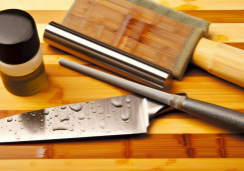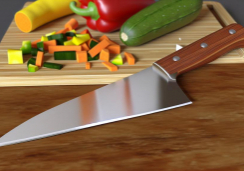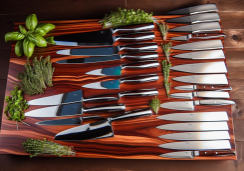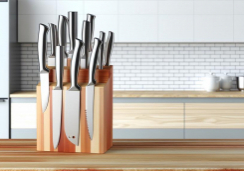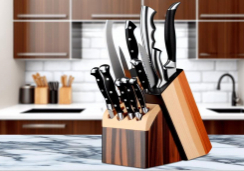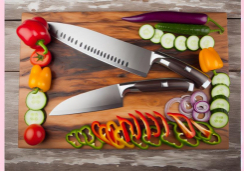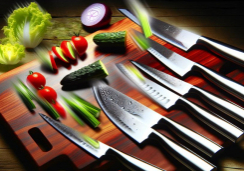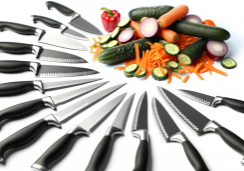Top Kitchen Knives for Perfect Vegetable Prep
Did you know that nearly 80% of home cooks believe the right knife can make or break a culinary experience? It's true, and when it comes to prepping vegetables, the stakes are just as high.
You're likely aware that a dull knife can be a chef's worst enemy, leading to uneven cuts and a higher risk of injury. What you might not know is which knives will turn your kitchen prep from tedious to effortless.
Whether you're julienning carrots, mincing herbs, or chopping butternut squash, there's a blade that's designed to make your task smoother and more precise.
In the following sections, you'll discover the essential knives that should grace your kitchen and how each one can transform the way you handle vegetables.
Stay tuned to unveil the key to elevating your culinary prep to the levels of professional chefs.
Essential Chef's Knives for Vegetables
When prepping vegetables, a sharp and versatile chef's knife becomes an indispensable tool in your kitchen arsenal. You'll want a blade that's adept at slicing, dicing, and mincing a variety of produce, from the softest tomatoes to the toughest squashes.
Opt for a chef's knife with a blade length of 8 to 10 inches, which provides ample space for a rocking motion, facilitating quick and even cuts. A high-carbon stainless steel blade is your best bet—it resists corrosion and maintains a sharp edge longer. The handle should feel comfortable in your hand, giving you control and precision without causing fatigue.
You'll notice that the weight and balance of a chef's knife are critical for efficient vegetable prep. A well-balanced knife will have a bolster—the thick junction between the handle and the blade—that aids in the knife's stability and eases the cutting process.
Don't overlook the importance of regular maintenance. Honing your chef's knife before each use realigns the edge, and periodic sharpening ensures it remains razor-sharp. With the right chef's knife, your veggie prep won't only be faster but also more enjoyable, allowing your culinary skills to shine.
Paring Knives for Precision Cuts
For intricate tasks like peeling and coring, a paring knife with its short, sharp blade is your go-to tool. Its petite size gives you exceptional control for precision jobs that larger knives can't handle with the same finesse. When you're maneuvering through the delicate work of trimming, shaping, or making decorative cuts, the paring knife becomes an extension of your hand.
Here are key features to look for in a paring knife:
- Blade Length: Typically 3-4 inches, perfect for detailed work.
- Sharp Point: Ideal for piercing and scoring produce skins.
- Comfortable Handle: Ensures a secure grip for steady, controlled cuts.
- Quality Steel: High-carbon stainless steel stays sharp and resists corrosion.
- Full Tang: Adds balance and strength, enhancing precision.
Santoku Knives for Slicing and Dicing
While a paring knife excels in precision tasks, a Santoku knife's versatile design makes it a superb choice for slicing and dicing a variety of vegetables with ease. Originating from Japan, the Santoku knife typically features a 5 to 7-inch blade with a flat edge and a sheepsfoot blade that curves down at an angle approaching 60 degrees at the point. This unique shape allows for a more efficient chopping motion, where you can easily employ the 'up and down' technique without the need for horizontal pushing or pulling.
You'll find that the Santoku's sharp, straight edge affords clean cuts, ensuring your vegetables are sliced uniformly, which isn't just visually appealing but also important for even cooking. Additionally, the knife often includes 'Granton' (scalloped) edges, which create tiny air pockets when cutting, preventing food from sticking to the blade and facilitating a smoother, faster chopping experience.
When you're looking to swiftly process a heap of vegetables, the Santoku is your go-to tool. Its balanced weight distribution and ergonomic handle design offer comfort and control, reducing hand fatigue during repetitive tasks. Remember to maintain the blade's sharpness for peak performance, and you'll be dicing onions, mincing herbs, and slicing bell peppers like a seasoned chef in no time.
Nakiri Knives for Leafy Greens
Shifting focus to leafy greens, you'll find the Nakiri knife's straight, thin blade is tailor-made for chopping lettuce, spinach, and other greens with swift, clean cuts. What sets the Nakiri apart is its ability to make precise cuts without damaging delicate leaves. The straight edge allows for a full cut through vegetables, minimizing the need for a sawing motion that can bruise or wilt your greens.
When you're looking to add a Nakiri to your kitchen arsenal, consider the following:
- Blade Length: Ideally, a Nakiri blade should be between 5 to 7 inches to handle large leaves with ease.
- Material: High-carbon stainless steel is preferred for its sharpness and durability.
- Handle Comfort: Look for a handle that feels secure and comfortable in your hand, as this will improve control.
- Edge Retention: A knife that keeps its edge longer reduces the frequency of sharpening.
- Flat Profile: The flatter profile of the Nakiri knife is perfect for the up-and-down chopping motion.
Serrated Utility Knives for Tomatoes
Having covered the Nakiri knife for leafy greens, let's now turn our attention to the ideal tool for slicing tomatoes: the serrated utility knife. When you're aiming for precision and ease with those plump, juicy tomatoes, the serrated utility knife is your go-to blade. Its saw-like edge grips the tomato's skin, slicing through effortlessly without squashing the delicate interior.
You'll find the serrated utility knife typically ranges from 4 to 7 inches in length, giving you the versatility to handle both large beefsteak tomatoes and smaller varieties with equal proficiency. The serrated edge isn't just for tomatoes; it's excellent for any soft fruits and vegetables where a smooth blade might slip or mash.
When you choose a serrated utility knife, look for one with sharp, pointy teeth and a comfortable handle that ensures a secure grip. A quality knife will have a full tang—the blade metal running through the handle—which provides better balance and longevity. Remember, while these knives stay sharp longer due to their serrated edge, they do require proper maintenance. Sharpening might need professional assistance, but it's infrequent compared to your straight-edged knives.
Invest wisely, and your serrated utility knife will make preparing tomatoes, and similar foods, a breeze.
Conclusion
You've now explored the top knives for veggie prep—each with its unique edge.
Your chef's knife is your versatile go-to, while a paring knife offers meticulous control.
A santoku brings precision to slicing and dicing, and a nakiri makes quick work of leafy greens.
Don't forget a serrated utility knife for the perfect tomato slice.
Equipped with these tools, you're ready to tackle any vegetable that comes your way with culinary prowess.
Happy chopping!

